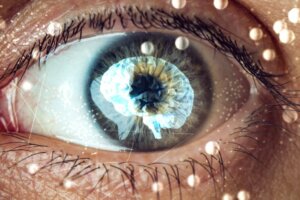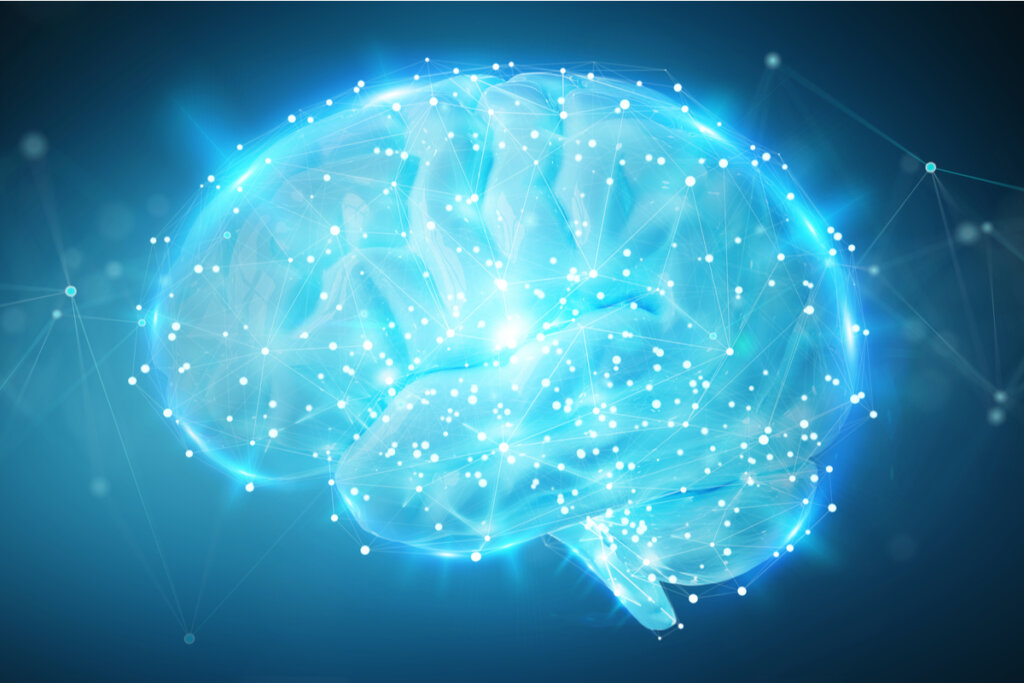The Ganzfeld Effect: A Fascinating Look Inside Your Mind

Your brain builds your own reality. It’s also in charge of interpreting it. In fact, it receives electrical and chemical information sent by your senses. These environmental signals are generally variable. However, in a few circumstances, they’re homogeneous. In fact, it’s when these circumstances occur that a strange effect known as the Ganzfeld effect can happen.
Everything that you perceive in the world has a structure. They’re all different and they produce different sensory stimulation at different rates.
Furthermore, in nature, change is the rule. In fact, your brain has adapted to change in order to build your perceptions, your world and to form what remains in your memory as experience. However, what would happen if you came across the exception? A stable, unchanging, and unstructured condition? What effects would it have on you?

The Ganzfeld effect
In 1930, Wolfgang Metzger (researcher of Gestalt theory) introduced the concept of “Ganzfeld”. This term is made up of the German expression Ganz (translated as ‘integer, complete’) and Feld (translated as ‘field’). Hence, together it means ‘complete field’ or ‘entire field’.
This term refers to a uniform and unstructured space that stimulates the senses. It’s also known as a “homogenized field”. This is because it’s the same in all its elements. One example is a clear, monochromatic blue sky. Another, the darkness of a room where nothing can be seen at all.
For these situations to be categorized within the Ganzfeld effect, they must be homogeneous, and not contrast with other stimuli. Indeed, the same should be perceived in whatever direction or at whatever point you look. In the absence of an objective structure, these conditions generally elicit perceptions. In other words, they favor or provoke hallucinations.
The studies carried out in this field have been, for the most part, done at the level of the sensory input of the ears and eyes. Another phenomenon that’s occasionally observed in these situations are episodes of “complete disappearance of the sense of vision for short periods of time”. They’re also called “blackouts” (Wackermann, Pütz & Allefeld, 2008).
These blackouts are caused by the habituation of sensory receptors and neurons. They’re the reason why, when you wear a watch for the first time you feel it instantly on your wrist. However, you then stop noticing it. This is because neural responses cease when stimulation is invariable and constant.
From all of the above, we can affirm that the Ganzfeld effect is the set of perceptions that are experienced as a product of immersion in a homogenized, uniform, or unstructured field.
The perceptions of the Ganzfeld effect
These perceptions vary from person to person. Wackermann, Pütz, and Allefeld (2008) state that visual images of the Ganzfeld effect generally appear and disappear suddenly. Sometimes they appear as sudden and dynamic changes.
These authors collected some testimonials from people who’ve experienced this effect:
“An urban landscape, like an empty avenue after rain. Large areas covered with water and the line of the sky of the city reflected on the surface of the water like in a mirror.”
They also recorded visual and auditory experiences, the product of homogeneous fields in both directions:
“It was like running a sled on a bumpy track. [There was] snow or maybe running water. I could hear music, there was music from the lower left side. “
These complex hallucinations are not all affected by the Ganzfeld effect. Some people may perceive simple patterns, dots, or zigzag stripes. Others, as we’ve seen, may experience more complex and structured perceptions. Indeed, the effects are variable and different in each person.
How to generate the Ganzfeld effect
The core of the technique is exposing a person to homogeneous and unstructured sensory stimulation (Schmidt & Prein, 2019). It should be administered consistently and monotonously to avoid variability in sensory signals.
Visual techniques to generate the Ganzfeld effect
Various complex strategies have been created to reproduce the Ganzfeld effect at home. For example, observing smooth walls on a large scale or translucent globes illuminated by diffuse light. Also, simpler ones have been proposed. For instance, cutting a ping-pong ball in half and using a half to cover each eye. They should be shaped to the face so there are no gaps to let the light in. Furthermore, to stop them from falling off they need to be taped to the face.
Another way is to make an eye mask out of white paper. Cotton balls can be glued around the edge of the mask to stop any light from entering. Another alternative is to buy some Ganzfeld glasses.
Auditory techniques to create the Ganzfeld effect
To achieve aural homogeneity, white noise, such as untuned TV or radio sound, or pink noise can be used. The important thing is that the sound is uniform.
The techniques, both visual and auditory, can be used together. It’s also recommended to avoid any distractions from the stimulation of your other senses. As far as possible, you should carry out the experiment in a quiet place.
This type of experiment isn’t dangerous. However, it isn’t recommended for those people who’ve already had problems of a psychotic nature. This is because we don’t know the type of perception or hallucination they might experience.
Why do these hallucinations occur?
Visual hallucinations, a consequence of the Ganzfeld effect, can be the result of a neuronal amplification of the brain. In effect, your brain is looking for the missing visual signals. The superior visual cortex interprets the neural noise. This causes hallucinations (Dunning and Woodrow, 2013).
In the same way, it’s thought that the patterns that are observed, such as zigzag lines or dots, are the result of phenomena that occur in the retina. Receptor cells in the retina exhibit spontaneous activity, supersaturation, and inhibitory reactions. Prolonged exposure generates complex perceptions that involve the central nervous system (Zdravković, 2016).
The internal model
Reality, as you see it, hear it, smell it and feel it, doesn’t come from outside. It comes from within. In fact, your brain builds its own reality before receiving information from your senses. This is known as the internal model.
Neuroscientist David Eagleman (2017) states that the foundation of this model can be observed in the anatomy of the brain. Almost all sensory information passes through the thalamus, on its way to the region of the brain responsible for processing these signals. There are many connections that go from the thalamus to the cortex. However, there are many more that go in the opposite direction (cortex-thalamus).
Your expectations of the world are transmitted from your brain to your thalamus. This structure examines what comes from the senses and compares it with your expectations. The thalamus only reports on discrepancies between the signals from the senses and what the internal model has predicted.
Eagleman states that “instead of using the senses to reconstruct reality at every moment from scratch, you compare the sensory information with an internal model that the brain has already built: it updates it, refines it, corrects it ” (Eagleman, 2017, p.71 ). The above is proof that reality isn’t external, but internal. Indeed, it doesn’t depend on what’s outside, but what’s inside. In effect, your senses don’t capture the world as you perceive it. Your brain builds it all.
This model allows us to propose another explanation for the hallucinations of the Ganzfeld effect. That’s because it doesn’t require much sensory information to perceive. In fact, when the brain doesn’t receive signals other than those of the homogeneous field, it has no more new information to contrast and it unleashes its model of reality.

An effect that invites reflection
The Ganzfeld effect is one more example of the particular functioning of the brain. It challenges the common sense that tells you that everything you perceive exists that way in the outside world. It makes you perceive shapes, lines, points, colors, and even situations that are only happening inside you.
This effect leaves the doors open to continue reflecting on reality. If, what you perceive has no sustenance in the external world, is it real? If not, then what is real? On the contrary, if you consider that these perceptions are real, what makes them so?
All cited sources were thoroughly reviewed by our team to ensure their quality, reliability, currency, and validity. The bibliography of this article was considered reliable and of academic or scientific accuracy.
- Dunning y Woodrow, P. (2013). ColourBlind: machine imagination, closed eye hallucination and the Ganzfeld effect.
- Eagleman,D. (2017). El cerebro. Anagrama.
- Schmidt, T. T., y Prein, J. C. (2019). The Ganzfeld experience—A stably inducible altered state of consciousness: Effects of different auditory homogenizations. PsyCh journal, 8(1), 66-81.
- Wackermann, J., Pütz, P., y Allefeld, C. (2008). Ganzfeld-induced hallucinatory experience, its phenomenology and cerebral electrophysiology. Cortex, 44(10), 1364-1378.
- Zdravković, S. (2016). Ganzfeld. Luo, M. R. (2016). Encyclopedia of color science and technology. Springer Reference.(pp.679-683). Springer Reference.
This text is provided for informational purposes only and does not replace consultation with a professional. If in doubt, consult your specialist.








